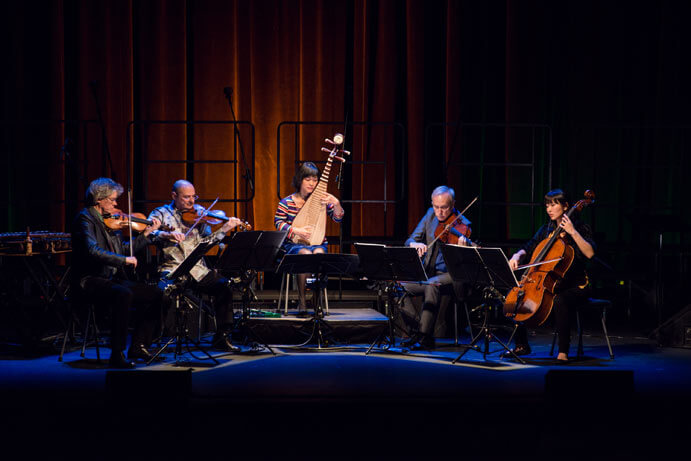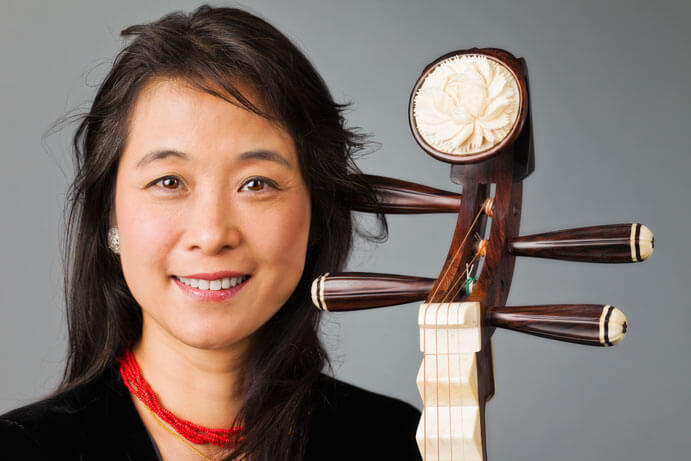Pipa virtuoso and cultural ambassador of music from China Wu Man has an active career as a soloist, educator, and composer, giving her lute-like instrument a new role in both traditional and contemporary music. We spoke with her about her music and upcoming performances at Big Ears Festival in Knoxville, Cleveland Museum of Art, and the Ojai Music Festival.
What are your goals and aesthetic ambitions as a musical artist?
My chief goal as an artist has been introducing the pipa to audiences who may not be familiar with it and sharing the wealth of music from China and other Asian countries, whether it’s through traditional works, new compositions that push the boundaries of how a pipa can be played, or the interpretation of music from other cultures around the world. One of my greatest blessings has been the opportunity to work with musicians from so many backgrounds, including the Kronos Quartet, Bang on a Can, and my fellow members of the Silk Road Ensemble, three groups with which I have enjoyed longstanding, fruitful relationships. When I was a teenager, I heard Isaac Stern give a master class at my conservatory in China and that experience contributed a great deal to my decision to move to America in 1990. Even though I hardly knew any English, I knew that coming here would challenge me out of my comfort zone into being more creative and forward-thinking while allowing me to form the new avenues of multicultural exchange that are so important to me.
What are some of the unique characteristics of your instrument, the pipa?
The pipa, one of China’s oldest instruments, has a rich history of over 2,000 years and is still a popular choice for budding musicians today, not unlike the guitar here in the US. I started out when I was nine by learning the liuqin, which is a smaller version of the pipa played with a plectrum (pick), similar to a mandolin. Three years later I ran out of material to learn, according to my teacher, and picked up the pipa, eventually getting transfixed enough to become the first person to obtain a master’s degree with the instrument from the Central Conservatory of Music in China. I also play the ruan, a full-moon-shaped mandolin with a deeper sound.
My love for the pipa is rooted in its vast vocabulary, with nearly a hundred different plucking techniques involving both hands. The difficulties lie in switching from elegant, slow techniques to lightning-fast ones. I’m always trying to think of new ways to let my pipa speak, sing, shout!
What will you be performing at the 2015 Big Ears Festival?
I’ll be performing a solo set and in the headlining concert with the Kronos Quartet, the 2015 Artists-in-Residence, with whom I’ve collaborated since 1992. My relationship with the Kronos Quartet was a big turning point in my career, expanding my conceptions of what it means to be a musician. We’ve collaborated in so many live performances of new works or arrangements and we have recorded on five albums together so far, with more in store. In the headlining concert at Big Ears, in celebration of Terry Riley’s 80th birthday this year, we will perform his work The Cusp of Magic, which he wrote for us during his 70th birthday season. I remember with fondness working with Terry on the piece in 2005 and how the influence of Indian musical traditions impacted the way he wrote for the pipa. It resulted in my part being very rhythmic, unlike most Chinese traditional music, and more like jazz guitar, challenging to play but beautifully colored.

Wu Man with Kronos Quartet (photo: Lenny Gonzales)
You’ll be playing your multi-media project Ancient Dances in Cleveland; how did that collaboration come about?
Part of pipa history is its close ties to the practice of traditional Chinese poetry, and this inspired me to use the poetry of eighth-century poet Li Bai to develop Ancient Dances with Guangzhou-born, New York-based composer Chen Yi, video artist Catherine Owens, who has designed visuals for tours and music videos for U2, and percussionist Robert Shulz of the Boston Modern Orchestra Project and other groups.
I was drawn to explore the inner relationships between music, poetry, calligraphy, and paintings, all originating or taking inspiration from the prosperous Tang Dynasty. The music parts in Ancient Dances for both pipa and a variety of Chinese and non-Chinese percussion instruments include elements of the Chinese classical or folk language, and each of the three movements is based on a poem by Li Bai, written in calligraphy with dancing lines and shapes in layers of ink. Calligraphy and the pipa are two of the crown jewels of ancient Chinese culture, with a history across millennia during which they played crucial roles in education, entertainment, meditation, and intellectual development. The most special part of Ancient Dances for me however, is the video art, which incorporates paintings by my father. They’re mostly of birds and flowers made with ink brush in the classical style and projections of these paintings accompany the music according to the poems during the performance. As such, this piece truly shows the interplay between these four organic art forms.
How did you get involved in this year’s Ojai Music Festival?
Although I’m making my Ojai Festival debut, my relationship with this year’s Music Director Steven Schick goes back years. We first collaborated when he was the percussionist in Bang on a Can All-Star, and we performed together in 2010 with the La Jolla Symphony, where he is Music Director. We’ll be performing Lou Harrison’s pipa concerto, which he wrote in 1997 during his 70th birthday season, commissioned by the Lincoln Center for the Performing Arts. The challenge to this piece is that it’s not composed in the classical Chinese style. While the score indicates what notes to play and includes dynamic, tempo, and articulation markings, there isn’t any pipa-specific notation such as fingering and plucking style. This puts the responsibility on the player to create the performance style on her own; the work is transformed from what’s on the page to what’s heard on the stage. In addition to the Harrison concerto, I’ll be performing solo and chamber works and participating in talks at the festival, and at Ojai at Berkeley the following weekend.
Upcoming Performances:
March 27-29, 2015: Big Ears Festival, Knoxville, TN
April 8, 2015: Cleveland Museum of Art, Cleveland, OH
June 10-14, 2015: Ojai Music Festival, Ojai, CA
June 19-20, 2015: Ojai at Berkeley, Berkeley, CA
Recent Release:
Our World In Song (An Odyssey of Musical Treasures), with Luis Conte, and Daniel Ho, a 57th Grammy Award nominee for Best World Music Album





















